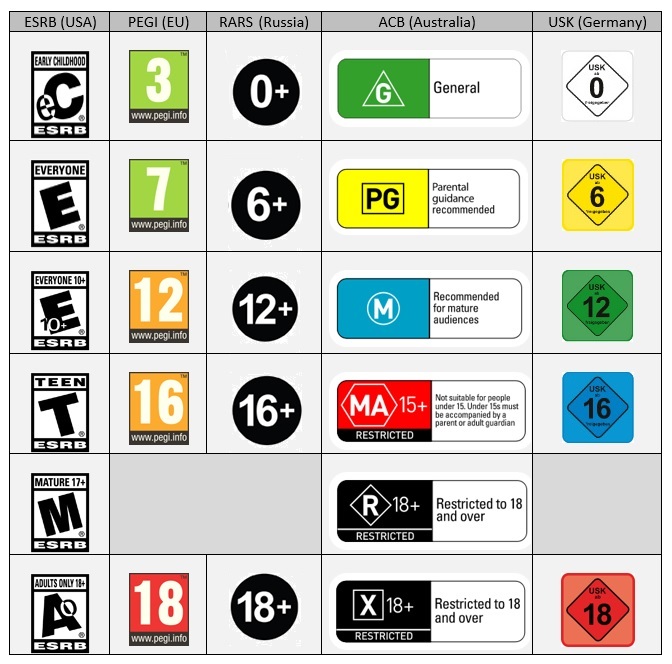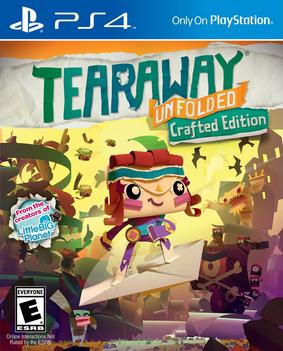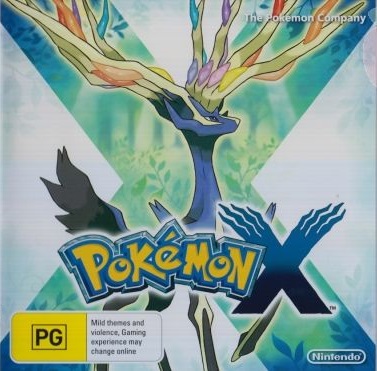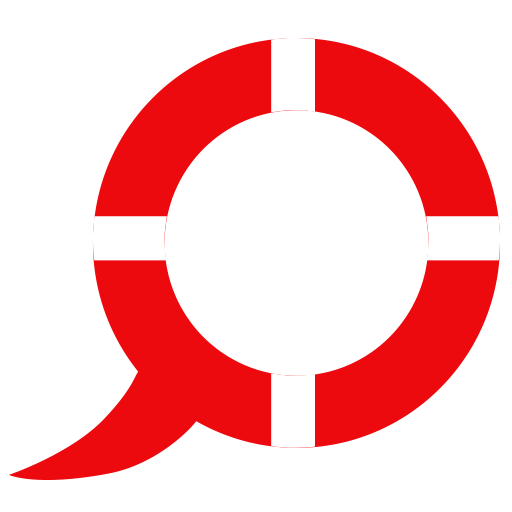We all must have seen age-based rating labels displayed before the TV show or featured on website headings, print media title pages, or theater posters. Such labels are also displayed on the games’ boxing.
What do they stand there for? Obviously, in the first place, they serve to inform the consumer that the contents might be somehow undesirable for children. In many countries a person must present an ID on purchasing a game, and in some cases certain games marked with a partucular rating would be prohibited from selling at all.
In this blogpost we will review different rating systems used to label console and PC games.
Different classification systems
Age-base rating systems in different countries can vary critically. Whereas the classification systems in Russia, Europe and Germany are based purely on age, the rating systems in USA and Australia might be interpreted with consideration of factors other than age. For example, in Australia there are two different 18+ ratings applied to either adult content or pornographic materials.

Age-based classification of games and entertainment software in the US is regulated by a state organization called ESRB (Entertainment Software Rating Board). ESRB rating system is not restrictive rather advisory, however, ESRB supports retailers’ voluntary policies to restrict selling of M and AO rated games to underaged consumers (children under 17-18 years old).
In Russia, the general age-based rating system RARS (Russian Age Rating System) is applied to all informational materials and is as well non-mandatory. The legislative basis for age ratings in games is the Federal Law «On protection of children against information prone to damage their health and development».
In European Union, the general advisory age-based rating system for games and software is called PEGI. Curiously, this system is applied beyond EU countries – in Russia (should the domestic classification is absent for any reason) and Ukraine. However, some countries in EU prefer their own age-based rating systems: for instance, in Germany age-based classification of games is handled by Unterhaltungssoftware Selbstkontrolle.
In Australia the age-based certification is the responsibility of Classification Board, which supervises the classification of games, entertainment software and movies. Should any piece of production be denied classification, it is prohibited to distribute and sell in the country. At the same time, this decision is not final: South Australia has another Classification Committee which is in power to revoke the decision of National Classification Board on its territory.
How it works for core games
Curiously, the same game might be rated differently in various countries. The rating is influenced by several factors like national mentality, current affairs climate, religion and the likes. Here is a good example of how the view of the same content might vary.

-
SIMS 4 received the following ratings:
- ACB (Australia) — M (Violence and sexual references)
- RARS (Russia) — 18+
- PEGI (EU) — 12+ Non realistic looking violence towards human characters – Sexual images and/or sexual innuendo – Violence causing minor injury only
- ESRB (USA) — T – teen (Crude Humor, Sexual Themes, Violence)
- USK (Germany) — 6+
As we see, Russian advisory board rated the game most strictly – obviously, for violating the following terms of the Children protection law:
The following information is prohibited to distribution to underaged audiences:
4) that defies traditional family values, promotes non-traditional sexual roles, and nurtures disrespect to parents and/or other family members;
In fact, the game presupposes freedom of choice when it comes to selecting a partner: it can be both a man and a woman. This action is not imposed — so game does not presuppose creating a homosexual couple. Any action is chosen by a gamer, and default characters and families are heterosexual. One should apply some effort to create a homosexual couple.
Once we take into the account family values and respect towards parents, the game presupposes the ability to neglect responsibilities to take care of a baby or raise a child, but this action will have consequences: the social care officers would come and take the baby away. There is also an opportunity to quarrel with other characters – parents, friends, or random people. In general, there is no instruction to perform ‘negative’ actions in the game, yet there is an opportunity. Apparently, that was the reason to rate the game so restrictively.
In the US, Sims 4 was rated Teen (13+). The respective content characteristics are below:
«Content is generally suitable for ages 13 and up. May contain violence, suggestive themes, crude humor, minimal blood, simulated gambling and/or infrequent use of strong language». Out of all the above, Sims 4 features only «explicit sexual content of moderate impact».
In Australia, the game was rated М (Mature) («the game might contain violence and nudity of moderate impact»). That means Sims 4 is recommended to children over 15 but is not prohibited for purchase by children under 15. The right to decide whether the content is appropriate for a child belongs to parents.
In Europe, PEGI rated Sims 4 as 12+. This category tolerates non-graphic violence and nudity, and bad language in this category must be mild and fall short of sexual expletives
Germany decided to bypass PEGI and rated the game as 6+. In Germany, age-based ratings mostly consider violence. In fact, there is no explicit and glaphic violence in Sims 4, besides an opportunity to kill-off the character. At the same time, the death won’t be depicted realistically and the game does not display blood.
How it works for children’s games
When it comes to children’s games, age-based rating is mostly there to evaluate the complexity of the gameplay for a child, however, the possibility of violence is also considered.

For instance, the game called Tear Away which did not presuppose very complex tasks (which, however, were to a certain extent challenging to a 2-3year old kid), was rated as follows:
- ACB (Australia): G
- RARS (Russia): 6+
- PEGI (EU): 3+
- ESRB (USA): E – Everyone
- USK (Germany): 0+

- ACB (Australia): PG – Parental guidance recommended
- RARS (Russia): 6+
- PEGI (EU): 7+
- ESRB (USA): E – Everyone
- USK (Germany): 0+
How to use age-based ratings
Don’t fully trust the ratings – in most cases the age labeles on the boxing is just a recommendation.
-
Before purchasing the game:
- 1.Read reviews on gamespot.com or ign.com
- 2.Watch game streaming on YouTube to have your own assumption of the game.
- 3.Compare how the game was rated in different countries and read descriptions of the contents.
Purchase games responsibly.
The game won’t harm your child if you choose smartly. Once you neglect to control your child’s choice of games, restrict the time your kids spends gaming, or conduct any research before purchasing, this might inflict damage on your child’s well-being and education.
 Kids Safety
Kids Safety





